Baengnyeong Island: The world’s uniquely beautiful military frontline
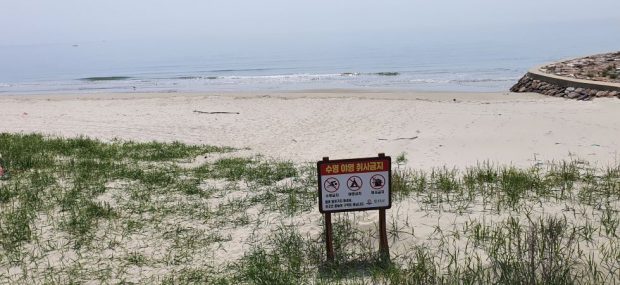
Baengnyeong: Stunning attractions co-exist with security concerns stemming from military confrontation with North Korea
By Habib Toumi
Baengnyeong, South Korea: On my first trip to Baengnyeong Island, the northernmost South Korean Island and right at the tip of the Northern Limit Line dividing the two Koreas, I stared at the tall majestic cliffs and the narrow stretch of water separating by 12 kilometers the two countries and wondered how I would recall it once I am away.
Will it eventually be the island of amazing natural beauty or the island dotted with imposing military fortifications?
Will I refer to Sago beach, a uniquely natural airfield thanks to its diatomaceous earth, or to the military, omnipresent and potent?
Shall I recall the breathtaking Dumujin rocks jutting proudly in the sea or the radar stations and watchtowers on top of splendid green hills across the island?
Maybe my memories will retain most the resilient faces of the residents, mainly farmers and fishermen, so focused on their work in the tranquil place and so oblivious to the threats of North Korean rhetoric.
But there are also the officers and soldiers in their impeccable uniforms walking and talking together, diffusing an air of defiant contentment all around.
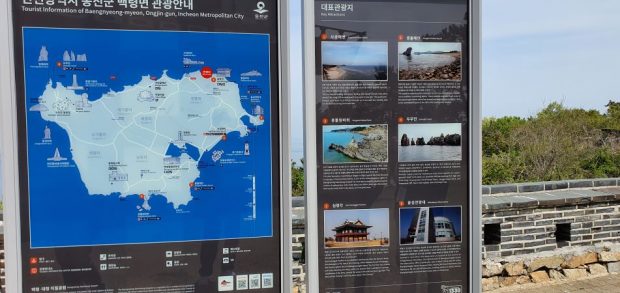
Information is readily available to highlight Baengnyeong’s major attractions
“Many of us here opt to extend the initial period assigned to us here,” a soldier said, standing erect. “Despite all the tension enveloping the island, we like the calmness and the serenity.”
As we, a group of media figures from Asia, set out to visit the island, we took the 8:30 am ferry from Incheon Ferry Terminal. The other boat departs in early afternoon. The journey lasts usually four hours after it takes a detour around North Korean coastal waters and remain outside the range of North Korean shore guns , before it reaches Baengnyeong, the third stop after two other islets just to its south -Socheongdo and Daecheongdo.
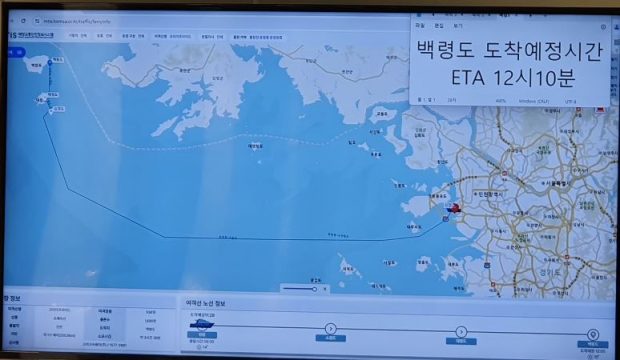
The boat’s four-hour journey
The boat was full, transporting a mixture of passengers, old people, students, soldiers … Some of the civilians were weighed down with the luggage strapped to their back and the bundles in their hands.
The young were mainly armed with their inevitable mobiles and small bags.
According to local officials, about 30% of the maritime journeys are canceled each year due to fog, heavy rain or other adverse weather conditions. Around 200 to 300 tourists visit Baengnyeong Island on weekdays and 500 to 600 on weekends.
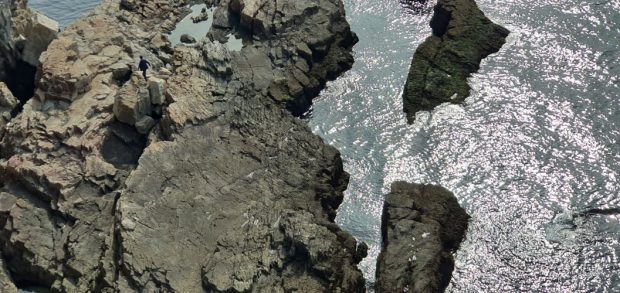
A tourist enjoys upclose the island’s memerizing natural beauty
Upon our arrival, a local guide drove us on the island’s serpentine roads through lush green hills and alongside carpets of rice fields. The area is wonderfully serene, and a sense of awe engulfs me as I contemplate the beauty and fecundity of the land.
Around 60 per cent of the civil inhabitants- numbers varied between 3,000 and 5,000- are rice farmers, while fishermen represent around 30% and the remaining 10% work in the service sector, including tourism, retail, and finance.
Farmland was secured through a reclamation project and a freshwater lake was created, but the area is still very salty and agricultural water relies on groundwater.
We had a Baengnyeong-style lunch in a rustic restaurant owned and managed by a local woman with a big smile, two or three words of English and a wish to ensure her customers are pleased with the quality of the food and the service.
The days are not always glittering for the restaurants here. There are not enough customers.
Those working in the tourism sector entertain high hopes that more people will be able to come and enjoy the island’s splendid beaches and breathtaking landscape, regularly described as one of the most attractive in South Korea.
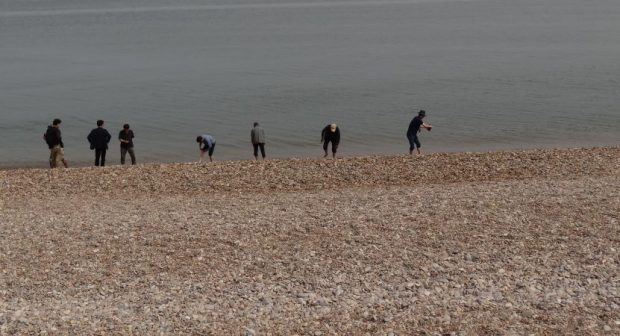
Visitors enjoy a special foot massage by walking on colorful bean-sized round and smooth pebbles
A rare natural asset is the countless colorful bean-sized round and smooth pebbles engulfing a sprawling beach are in themselves a special attraction and offer ideal conditions to walk barefoot on it.
Baengnyeong was the 14th largest island in Korea, but its size was expanded through two land reclamation projects conducted from 1991 to 2006, and it is now the eighth largest island in the country.
The mountains form a fascinating backdrop to an ideal holiday while the unspoiled coast and the glistening expanse of water festooned with birds evoke a sense of romance, blissfully oblivious to time.
And even though the countryside stubbornly refuses to allow its generous geography to crumble under the onslaught of the dramatic events that at times unfold on the island, history provides a reminder that a heartbeat away, potential danger is lurking.
Great care is taken by the local and national authorities to keep history alive and to ensure that the collective conscience of the people never forgets the pain the island and the country have suffered.
There is also hope that the local history, dramatic and omnipresent, could be a great motivation for South Koreans to visit Baengnyeongdo.
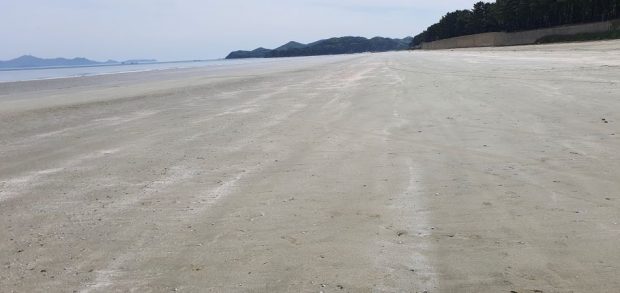
Sagot Beach, one of the island’s wonders, combines history and geography
Sagot Beach, a 4-kilometer-long and 200-meter-wide stretch of quarts and feldspar sand beach and spectacular low and high tides, is regularly with its diatomaceous earth used as a natural runway by military planes for take-off and landing during the Korean War …
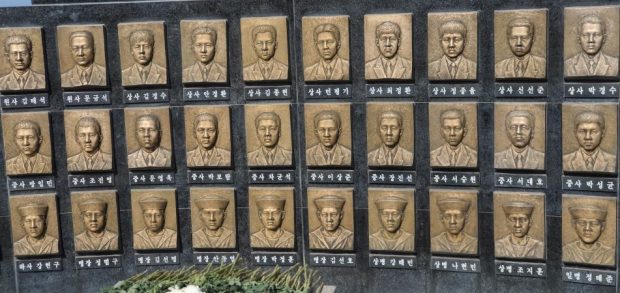
Bronze relief of the Cheonan 46 sailors killed in March 2010
On the coast of Yeonhwa village is the hilltop Cheonan Memorial that features the youthful faces in bronze relief of the 46 sailors killed in March 2010 when a North Korean torpedo sank the South Korean corvette Cheonan as it was sailing 2.5 kilometers away from the Baengnyeong’s coast.
The memorial overlooking the site where they were killed displayed pictures of the corvette and graphic information about how and where it was hit. A somber reminder of yet another shocking act of terror.
The islanders have been deeply affected by the attack, but over time they have shown fortitude and gradually rebuilt their lives without their lost sons, but kept their memories alive in multiple ways.
Many also seemed to have learned to live with the ominous threats emanating regularly from North Korea asking them to leave the island if they did not want to face “devastating consequences”.
Some said they wanted to remain on the island, content with their lives. For some, it is contentment with their lives, simple and rewarding. The government also gives them $100 a month as “danger money.” geographically disadvantageous location, and as a result, support is provided at the government level. In particular, the government is and provides subsidies of about $20,000 to people who have lived on the island for more than 10 years to remodel their old houses. The financial support is less for those who have not achieved the 10-year mark.
Other residents said they remained on the island because they did not really have alternatives to live on the mainland, some 190 kilometers away.
For most of them, peace with their neighbor is a magical word denoting an elusive dream, especially that Pyongyang insists that Baengnyeong as part of its territory as the maritime border should be drawn further south.
Yet, deep inside, they believe that “here is much safer than elsewhere” and do not want to take the cascade of North Korean threats seriously.
For the military stationed on the island and forming half of the total population, there is a solid zero tolerance for complacency..
Standing near a map design at the Observation on Eopjuksan Mountain, the highest point on Baengnyeong Island, an officer explained that they are responsible for “monitoring and observing the front lines 24 hours a day in peacetime and guiding firepower in times of emergency.”
Reporting on the security environment around Baengnyeong Island, he said that in the past they had to face “continuous provocations near Baengnyeong Island to neutralize the NLL and that from October to December 2022, a total of 530 firepower provocations were carried out five times to neutralize the September 19 military agreement.
The provocations were diversified and included ‘firepower provocations’, ‘sea provocations’, ‘air provocations’, ‘attacks by infiltration forces’, and and island ‘surprise strengths’, he added.
“Accordingly, the 6th Brigade of our Marine Corps will maintain a mental readiness posture to immediately, strongly, and thoroughly punish the enemy for any provocations and attacks by the enemy, and will absolutely defend the Northwest Islands by providing practical education and training and an impeccable decisive battle posture,” he concluded.
Major Park Hee doo, Marine 6th Brigade (Artillery Battalion), who attended the briefing said that the army staff stationed there were constantly monitoring the situation and making sure they were ready for any attempt to target the island in any way.
In Dumujin, we walk on a path over the hillside to see the famous quartzite “mysterious rocks” jutting up 50 meters in the air from the limpid waters of the sea — a true paradise for divers and sea lovers, a perfect postcard that contrasts sharply with the reality on the ground. The Kokkiribawi Rock, Janggunbawi Rock and Sinseondae Cliff form a remarkably serene sight – with North Korea in the background – that belies the deep political fissures in the peninsula.
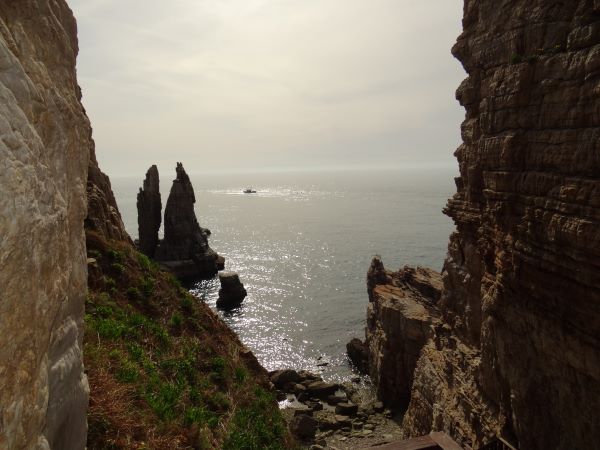
The gathering of high, spiky rocks in Dumujin
Nearby in the Sahang Harbor, we watch fishermen, their boats, their nets, their shops, and right ahead of them … North Korea.
The waters around Baengnyeong are their lives. The waters have also witnessed more military clashes and threats between the two Koreas than any other part of the peninsula.
So, how high are the risks of straying into North Korean waters?
Quite high, especially on foggy days. We are told that almost every fisherman has personal scaring stories about dashing to get out of the northern waters after entering them inadvertently.
One fisherman recalled how three of his friends were taken to North Korea and kept there after they were lost in the fog while fishing.
The sea expeditions regularly secure rich supplies of fish, octopus and crabs for South Koreans.
“Will one day North and South Korean boats fish peacefully together in this water?”
In the meantime, the sad stories of the fishermen’s seething masses of pent-up frustration and bitter vehemence contrast sharply with the serene surroundings and the sparkling joie de vivre and the elated giggles of students attending the local four schools – two elementary schools, one middle school, and one high school – with each of them accommodating 100 students.
The students, still too young to have been hardened by the75-year-long hostility and the deep-seated mistrust, may not yet appreciate fully the atrocities of the past and the threats of the present.
However, the skirmishes, the deaths and the subsequent military tensions that have occurred during their young lives are proving that they are growing within a forced dereliction of natural beauty and an unashamed assault on the sacredness of human life.
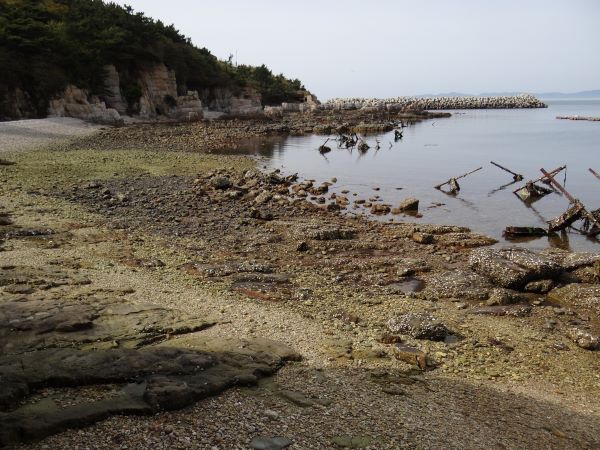
Steel columns help thwart enemy craft landing on the shoreline
The artillery positions, the bunkers, the barbed-wire fences along lovely beaches, the rusty steel columns to thwart enemy craft landing on the shoreline, the multiple “danger” and “mines” signs … should not be dotting the island more than 70 years after the end of the Korean war. Seven decades should have been enough to pave the way for genuine peace and coexistence.
For Major Park and the military, there is no other solution when enemy planes can reach them in less than three minutes, when the rhetoric is about death and devastation.
To them and to the civilians on the island, the Korean issue is not a surface wound that bleeds a little but is not life threatening, like many outsiders complacently claim as they bury their hands in the sand.
“The fortifications are a fortress against brutal attacks, a protection against aggression. We need to feel and be safe and secure. To the outside world, security, safety and stability are simple words, maybe distant connotations, but to us, they are the essence of our lives. We are happy here and the only thing missing is genuine and lasting peace.”
We go up to the Shimchong Pavilion. A well-known legend in Korea is the story of Shimchong who throws herself into the Indang Sea as a sacrifice so that her blind father can regain his eyesight. This selfless act of filial piety caused her to be resurrected and to become an empress, and her father’s blindness is cured.
There are three telescopes in front of the edifice. There is mist, but not too tkick not to see the North Korea landscape.
The maritime border and the buffer zone slicing Korea and generating controversies as well as the sea patrols compound the extraordinary picture of a divided country and make the scene ethereal. An ugly scar and a horrid reminder of the senseless onslaught on conviviality.
The whole situation is a bitter testament to a physical and psychological fissure that seems to declare the reunification of Korea is quasi impossible.
The island refuses to be trapped in such a gloomy situation or trapped in false hope.
They obviously live in their won world and have grown accustomed to the quality of life that they have. They want to enjoy their lives to the extent of the possible, and do not want to give second thoughts to the military installations around them or to the brutal rhetoric bombardment to which they are often subjected.
They are not as obsessed with the line as curious visitors, but they, torn between their hostility toward North Korea and hope for genuine peace, obviously want an end to the stalemate and menaces.
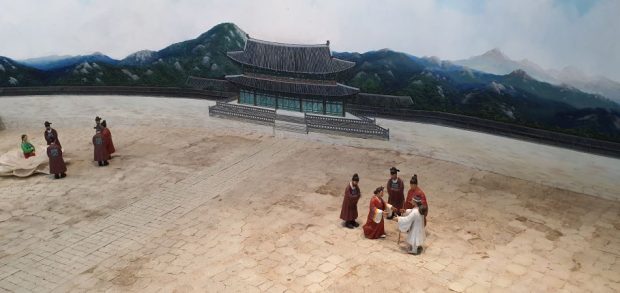
The legend of Shimchong remains vivid in Korea’s collective memory
The miracles in the Shimchong tale are vivid in the upbringing and collective memory of Koreans. Today, Baengnyeong, in particular, and Korea in general, do need another miracle that will end the seemingly inexorable threats and address the impasse that has plagued them for decades.










































